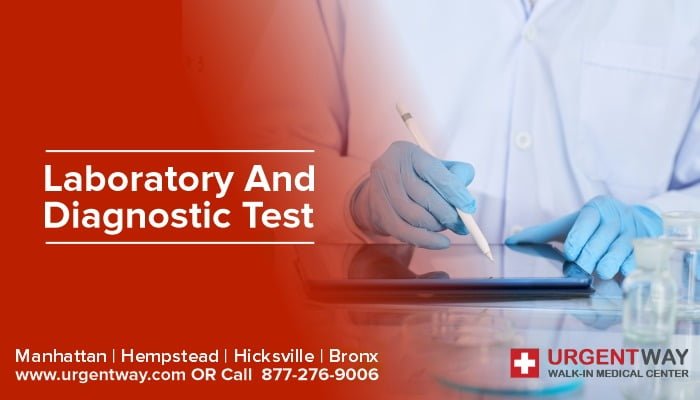Almost every chemical component in blood or urine may be detected and measured using various laboratory and diagnostic tests. Possible components are blood glucose, electrolytes, enzymes, hormones, lipids (fats), different metabolic chemicals, and proteins. A list of laboratory and diagnostic tests is available to obtain health information and diagnose the human body’s pathological and nonpathological states.
The following are some of the most frequent laboratory and diagnostic tests:
Complete blood count
The most common blood test, commonly known as a CBC test, is a laboratory and diagnostic test. It counts the different kinds and amounts of blood cells, such as red and white blood cells and platelets. This test is used to assess nutritional status, screen for diseases, and establish overall health status. It may assist in identifying conditions including anemia, leukemia, malaria, and infection by evaluating symptoms like weakness, tiredness, and bruises.
Prothrombin Time.
This laboratory and diagnostic test, often known as PT or Pro Time, determines how long it takes blood to clot. The presence and activity of five distinct blood clotting factors are measured in this coagulation test. This test may be used to check for bleeding irregularities and track blood clot-prevention medications’ effectiveness.
Basic Metabolic Panel
This lab and diagnostic test evaluate glucose, sodium, potassium, calcium, chloride, carbon dioxide, blood urea nitrogen, and creatinine and may be used to assess blood sugar levels, electrolyte, and fluid balance, and kidney function.
Panel of Lipids
A lipid panel is a collection of laboratory and diagnostic tests that are used to assess cardiac risk. Cholesterol and triglyceride values are included.
Urinalysis
This is a broad laboratory, and diagnostic test used to look for early indications of illness and is often the first lab and diagnostic test done. It’s also possible to use it to keep track of diabetes or renal problems.
Cultures
To diagnose and cure infections, cultures laboratory, and diagnostic tests are employed. UTIs, pneumonia, strep throat, MRSA, and meningitis may all be identified and tested to determine whether antibiotic therapy is necessary.
Biopsy
Surgical removal of a tiny sample of tissue from the body to be examined. This aids in the diagnosis of illness. They are occasionally used to determine whether or not a mass is malignant. They may also look for issues such as liver or renal dysfunction.
Colonoscopy
A colonoscopy is a diagnostic procedure that involves inserting a flexible tube called a colonoscope into the anus and into the rectum to examine the interior of the large intestine (the colon). This tube sends pictures to a screen that displays indications of a medical problem. It’s mainly utilized to figure out what’s causing gut-related issues like stomach discomfort or anus bleeding.
CT scan
A CT scan (computed tomography) is a kind of x-ray that produces 3-dimensional pictures of your body’s bones, organs, tissues, and tumors. To make a cross-sectional picture, the scanner travels in a circular motion around you, taking x-rays of small tissues of your body. CT scans may be used to diagnose and treat a variety of diseases, including tumors and infections, and check for damage after a severe accident.
Electrocardiogram (ECG)
An ECG is a graph of the electrical activity of your heart. It’s a risk-free test. There is no danger of electrocution. During an ECG, leads are attached to electrodes with sticky dots placed on your arms, legs, and chest. The leads are connected to a machine that reads the data.
Electroencephalogram (EEG)
An EEG records the electrical impulses transmitted between brain cells. This electrical activity is shown on a computer as “brain waves,” which a specialized doctor interprets. The EEG recording will reveal whether there is anything abnormal about the brain’s electrical activity. The electroencephalogram (EEG) is used to diagnose and monitor a variety of disorders, including:
- Epilepsy and other seizure disorders
- Sleep disturbances
- Tumors in the brain
- Injury to the head
- Stroke
- Dementia
Gastroscopy
Gastroscopy, also known as upper endoscopy, is a procedure that includes examining the upper digestive system using a thin, flexible tube (endoscope). Gastroscopy is sometimes used to treat bleeding ulcers, widen a small esophagus (known as dilatation), or remove a foreign substance.
Examinations of the eyes
Regular eye exams with an optometrist can ensure that your eyes are in good health condition. They may detect issues with your eyes before you are aware of them. To visit an optometrist for eye exams, you do not need a doctor’s recommendation.
Positron emission tomography (PET)
PET (positron emission tomography) scans are imaging tests that are used to detect certain illnesses. Doctors use it to detect tumors and diagnose heart problems, brain issues, and other ailments. PET scans may look at your whole body or just one part of it.
Ultrasound
An ultrasonic scan uses sound waves to produce a real-time image of the interior of the body. Ultrasound is a painless and non-invasive procedure. Ultrasound differs from x-ray in that it does not involve the use of radiation.
X-rays
Radiation is used to produce an image of the interior of the body in an x-ray. The picture is created by measuring how various structures absorb the x-ray beam in the body, such as bones and soft tissues. Radiography is another name for X-ray.
Various laboratory and diagnostic tests are used to diagnose and treat diseases. These laboratory and diagnostic tests are varied in their use. Still, their primary function is to determine the concentration of many components in the blood as blood cells, hormones, chemicals, sugar, and microbes. Widely used laboratory tests are complete blood count, pro time, basic metabolic panel, lipids panel, urinalysis, and cultures. At the same time, the most used diagnostic procedures are biopsy, colonoscopy, CT scan, electrocardiogram, electroencephalogram, gastroscopy, examination of the eyes, positron emission tomography, ultrasound, and X-rays. The development of laboratory technology decreases the rate of death in the world because diseases are diagnosed in the initial stage and can be controlled easily.


